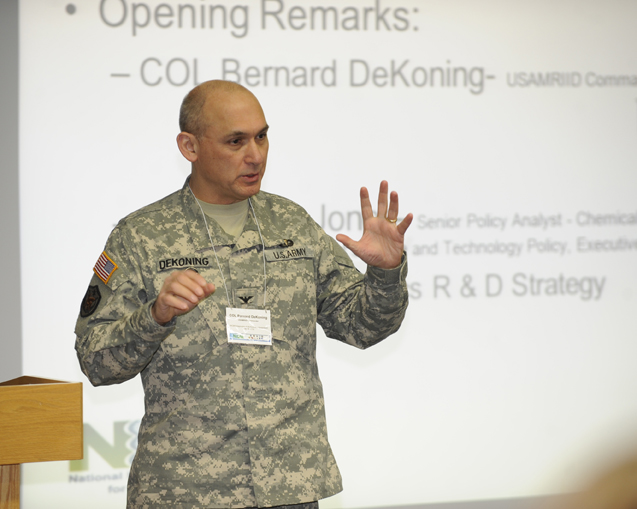NICBR Symposium Highlights Research on Diagnostics, Bioforensics

Scientists from multiple agencies of the National Interagency Confederation for Biological Research gathered at the National Cancer Institute-Frederick auditorium Feb. 16 for a symposium highlighting the latest advances in diagnostic and bioforensic technologies.
More than 100 people attended the event, kicked off by Col. Bernard L. DeKoning, commander of the U.S. Army Medical Research Institute of Infectious Diseases, which sponsored the symposium as a member of the NICBR Scientific Interactions Subcommittee.
"The confederation has grown to include seven partner agencies," DeKoning commented. "I think it's clear that we are forging new territory here at Fort Detrickâ?¦it's exciting to see the benefits of this collaboration as we leverage the unique capabilities of all these agencies."
Dr. Franca Jones of the White House Office of Science and Technology Policy was the opening speaker. She highlighted some of the issues her office handles, ranging from writing policy on how research is conducted to assessing concerns that arise at the intersection of science and national security.
Keynote speaker Dr. Peyton Hobson of the Food and Drug Administration talked about his agency's role in providing development pathways for diagnostics, which are treated as medical devices by the FDA for purposes of regulatory approval.
Research toward the development of diagnostics and detection systems involves the identification of novel biological targets, development of new or improved diagnostic assays, and critical testing and evaluation of system components, according to conference materials. A diagnostics and detection system requires assays, reagents, platforms, protocols, validation testing, and a concept of operations. The research and development path encompassing these focus areas is a complex process involving contributions from multiple independent scientific disciplines.
"It's never too early to seek FDA input," Hobson advised audience members working on new diagnostics. He commented that the agency is willing to meet with laboratory personnel, even in the early stages of assay development; in fact, this enables FDA to better assist in developing a regulatory science plan for each product.
The rapidly growing area of bioforensics, especially microbial forensics, examines trace amounts of material from a biological terrorism event, biocrime or natural outbreak. Bioforensic scientists answer important questions, such as what kind of biological agent was used, how it was prepared and delivered, and where and when it was made.
Afternoon sessions included Dr. Nick Bergman of the National Biodefense Analysis and Countermeasures Center, who gave a presentation on genomic-based bioforensic analysis, and colleague Dr. Steve Cendrowski, whose talk centered on detection and biological characterization of ricin in bioforensic samples.
Other speakers throughout the day-long event included scientists from the Naval Medical Research Center, the USDA's Agricultural Research Service, and the Defense Threat Reduction Agency, as well as NCI, NBACC and USAMRIID representatives.
Dr. Gene Olinger, who co-organized the symposium with USAMRIID colleague Dr. Aysegul Nalca, said he thought the event went well and provided an important forum for scientists to interact.
"The NICBR member agencies have made important contributions to the knowledge base that supports bioforensics and diagnostics and detection systems," he commented. "Moreover, we are poised to provide significant future discoveries in these critical scientific fields."
Symposia will be sponsored by the NICBR partners to provide continuing opportunities for the Fort Detrick scientific community to interact, exchange information on the research being done by each of the partners, and share technology and capabilities. Next on the horizon is the NICBR Forum on Commercial Biostabilization, scheduled for March 29 at the NCI-Frederick auditorium (building 549); for more information, refer to the following web link: http://web.ncifcrf.gov/events/Biostabilization/ 














